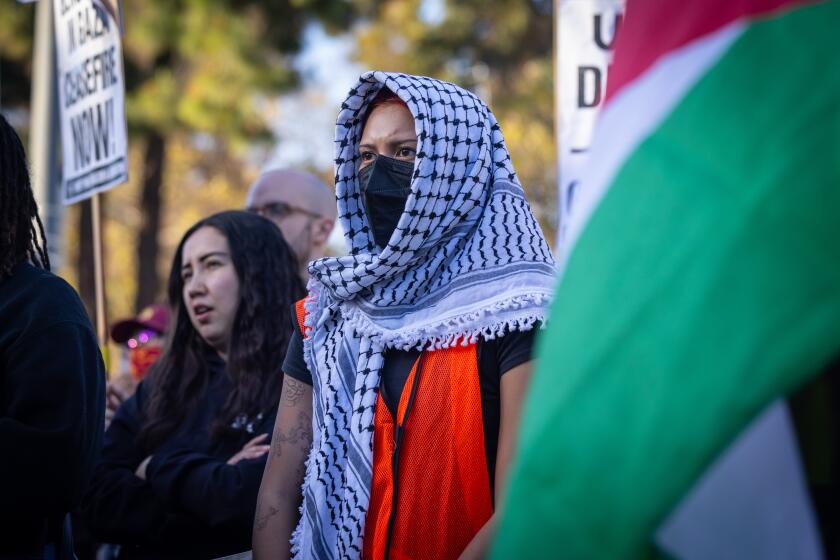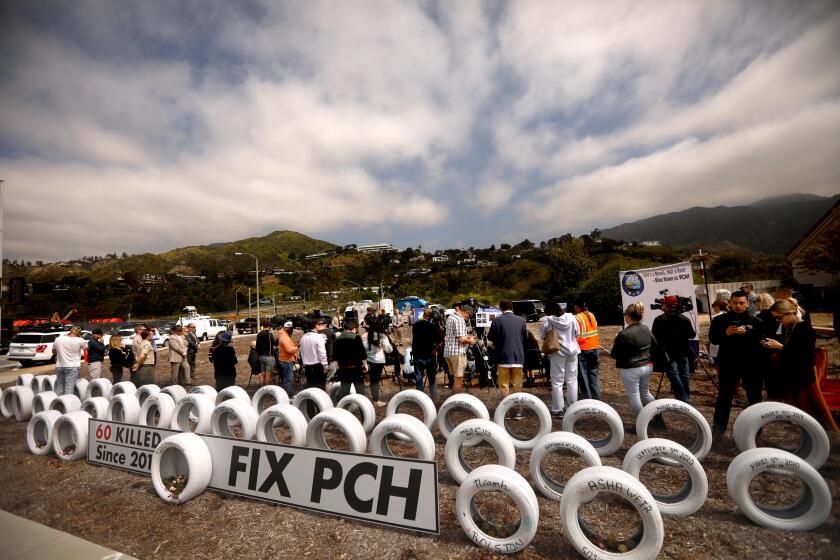Living in Fear : Specialists Act to Help Children Touched by Neighborhood Violence
Maribel Plascencia is a bright, sturdy, likable 11-year-old who can describe, without losing eye contact, the prostitution and drugs that used to plague her Anaheim neighborhood.
If asked, she will recite matter of factly the details of a murder she saw--a fatal stabbing that followed a drunken argument over barbecued hot dogs--almost as if she had watched it on television that very day.
She was 6 years old.
Her brother, Francisco, 8, is also wide-eyed but wary. Only with his mother’s prodding will he reveal that a neighbor pushed cocaine up the child’s nose two years ago. As he speaks, he pounds a half-hearted fist into his palm, his eyes dart back and forth.
Until now, he has never told anyone outside the family because he believed that the neighbor, who moved the same day as the incident, would kill his family.
These children belong to a new generation growing up amid violence of an extent and intensity unthinkable to previous generations. Over the past 25 years, homicide rates for children have at least doubled in all age groups, giving this country the developed world’s highest death rate for children.
Over the past six years, California in particular has seen a spate of mass violence involving children--shooting sprees at schools in South Central Los Angeles and Stockton and at a McDonald’s in San Ysidro. Four years ago, a woman committed suicide in front of elementary school children at Panorama School in Orange.
But more common, and less publicized, is the skyrocketing violence closer to home--the weekend fighting, the random shootings, the spousal beatings--that have become as much a part of growing up as losing baby teeth for an increasing number of children in Orange County--a place known as a suburban dreamland, ideal for raising children.
Said Michael Wellins, a crisis-intervention specialist with the Orange Police Department who is the county’s only full-time therapist on a police department staff: “You no longer have a sense of it’s not going to happen here, you see so much of it.”
It has happened in a Santa Ana living room, where a bullet fired from the street struck an 8-year-old watching TV. It has happened in the Orange Mall, where a 12-year-old brandished a gun and accidentally killed a friend. It has even happened on a ride at Disneyland, where a bullet from outside the park wounded an 8-year-old girl.
In addition to the victims, many more children are witnessing death, suicide, assault, and, most commonly, violence in their own homes, Wellins said. A few weeks ago, at least two children saw an Orange police officer kill their abusive father.
Last year, homicides reached a 10-year high in Orange County, skyrocketing 42% in Anaheim and 40% in Santa Ana. In four years, attacks by schoolchildren using weapons jumped 95% and the county now reports record highs in domestic violence, gang violence and officer-involved shootings.
The end result is a climate of fear that has made families angry, numb, vigilant. Or worried sick.
“I know a family who sleeps on the floor at night,” said Gloria Lopez, director of Anaheim Independencia Community Center. “They are afraid somebody will come and shoot at the kids who are there and it’s safer on the floor. They say, ‘My bed is now a luxury.’ ”
Mickie Camacho, 42, said her 7-year-old daughter, Emerald, mistakes firecrackers for gunfire since her 17-year-old brother died last September in a gang shooting four blocks from their Santa Ana home. When Camacho goes outside summer evenings to escape the heat, “She says, ‘Mom, come inside.’ ”
Sue Tonkins, a therapist at the Santa Ana Child Guidance Center, said: “I’ve had children say, ‘I found a shell of a bullet in my back yard.’ It’s amazing. You look at them and they don’t look affected. Their helplessness has become indifference.”
Christine Lopez, victim specialist for the Orange County Central Court Victim/Witness program, sees more children, some as young as 4, coming into court to testify to the violence they’ve seen.
Often, she said, they stare into space. “It looks as though they are in touch with an entirely different world. In that stare, you can see so much pain. And you can see, if you will, a coldness come over. You can almost see that child trying to cope with what their eyes saw.”
What frightens many families and youth authorities concerned with the future is that some children cope with what they have seen by copying it.
Wellins said that 45 minutes after the Panorama School shooting, a second-grader approached him, pointed his finger and shouted, “Pow!”
Darlene Doebke, a children’s program coordinator for a battered women’s shelter, said she has seen 4-year-old boys speak to their mothers in the same abusive voice and gestures used by their battering fathers.
Dick Weaver, principal at L.P. Webber Elementary School in Westminster, said second-graders have already begun to form their own junior gangs, imitating older neighborhood boys.
“Understand, this is not a fiction kind of issue,” Wellins said. “These kids are exposed to real, traumatic events such as the death of a brother or sister. It really leaves a stain unless that stain is dealt with.”
But while psychologists swoop in force initially upon the scenes of high-profile crimes where children are involved, in the most common cases, the children are often left to sort it out alone.
In the case of the children who saw their father shot by an Orange police officer, for example, Wellins said his job was to counsel the officer, not the family. Counseling the children, he said, would be construed as a conflict of interest. He did not know whether the mother had yet sought counseling on her own.
In many cases, parents do little to help their children. Either enmeshed in their own grief, or afraid to discuss death, many adults insist that children don’t understand death and don’t need help, said Tonkins, who also runs a new, free-to-the-public grief group for children at Fairhaven Mortuary in Santa Ana.
In fact, unlike the predictable stages of grief known to affect adults, grief washes over children in invisible waves, she said. “They may have very intense feelings, then act as if nothing’s occurred, then come back into it.
“Children are constantly re-grieving as they get older, going through different developmental phases, getting more understanding cognitively and emotionally. “
What they need is a chance to express whatever emotions they have, including guilt, or anger at the dead person, she suggested. What they don’t need are simple religious explanations or instructions to “be brave.”
Counseling, and particularly bilingual therapists, are scarce. There are no “warm,” or call-in help, lines for children north of Irvine. There are waiting lists for up to six months at public mental health clinics--even for children whose fathers have been killed, Tonkins said.
“There is no one, no one, going into these neighborhoods--even when small children are involved,” said Lopez of the Victim/Witness program.
“One of the main problems is denial that there is a problem,” explained Mike Salgado, 29, a native of Santa Ana, who recently formed Parents Against the Gang Environment and runs it from his home. “County and city officials have no idea how bad the problem really is. Kids are seeing their brothers die, cousins die, and end up doing the same thing. No one is there to reach them.”
Even the Boys Club of Santa Ana is located on a street so unsafe that “you would not allow your son or daughter to attend it,” Salgado added.
To reach children before the peer pressure of junior high reaches them, Salgado, who witnessed a murder in his own high school, is organizing outings for boys ages 7 to 13 who have lost friends or relatives to violence.
Though not the most common, the random, gang-related shootings provide the greatest jolts to a community, sending ripples of fear not only to surviving victims and witnesses, but to relatives, friends, neighbors and classmates, according to Ramon Daniel, a school psychologist in the Santa Ana Unified School District. And just hearing about a crime can be as damaging as experiencing it, specialists say.
“It gets children crying, turning physically ill, sometimes being scared of coming to school. Because the same thing could happen to them almost anywhere,” Daniel says.
Mondays in Santa Ana, elementary teachers brace themselves for more than the usual unrest, Daniel said. “There is often a lack of concentration and high distractibility. Sometimes they don’t talk about it. We have to probe and find out what’s happening. Sure enough, here comes the story--there was a drug raid, helicopter hovering over, all this excitement.”
Among the children Daniel has counseled is a boy whose father, a doctor in Latin America, was killed in a random freeway shooting. Two years later, the boy is angry, destructive, pushing, fighting. “He’s angry he doesn’t have his father.”
Like other professionals limited in what they can do, he hopes and prays that the boy can somehow work it out.
Until relatively recently, many professionals assumed that children could work it out.
“We thought children were resilient,” said Kathi Nader, a clinical social worker with the pioneering UCLA program in Trauma, Violence and Sudden Bereavement.
While research into adult trauma has been going on since the 1800s, formal studies of childhood trauma started only in the 1970s.
Now it is known that each previous trauma can make a child more vulnerable to Post Traumatic Stress Disorder, whose symptoms in children may include one or more of the following:
* Hypervigilence, or being frightened and on the alert for danger constantly.
* Reduced responsiveness to the world, similar to numbness in adults, but not always visible.
* A re-experiencing of the phenomenon in dreams or play acting.
In the UCLA researchers’ experience interviewing and treating hundreds of children exposed to sniper attacks, school shootings, murder, rape, suicide, gang violence and natural disasters, they have found that not all children turn violent after being exposed to violence. Some become chronic victims and others become rescuers--pursuing careers as nurses, doctors or police officers.
So far, there is no reliable way to predict how different children will react.
The UCLA program uses therapy to help some victims recall and work through their trauma, but the obvious solution is to remove children from exposure to violence, she said.
Some children, like the Plascencias, are lucky.
The neighborhood rehabilitation project that gated their community drove out much of the dangerous element, and their mother, Carmen, a non-English-speaking native of Mexico, has overcome her fear of police to become their active ally in a strong neighborhood watch program.
Both Maribel and Francisco want to be police officers when they grow up.
Meanwhile, Maribel wishes for a junior police patrol, a group of “mini-cops” who would roam the neighborhood, tell police where the drug houses are, go for help if people are in danger or just talk to kids about their futures.
Other observers wish for grief classes in the public schools or more bilingual therapists or more supervised care--none of which appears likely as governments prepare to pare their budgets.
Nancy Nobel, child-care coordinator for the city of Irvine, which operates the county’s only warm line for children, said she is considering a proposal to expand it countywide.
The new kind and degree of violence involving children is “a massive thing and we all feel overwhelmed,” Nader said.
“But one of the things you know with trauma is, as long as you’re feeling overwhelmed, it inhibits something being done.”
More to Read
Start your day right
Sign up for Essential California for news, features and recommendations from the L.A. Times and beyond in your inbox six days a week.
You may occasionally receive promotional content from the Los Angeles Times.






